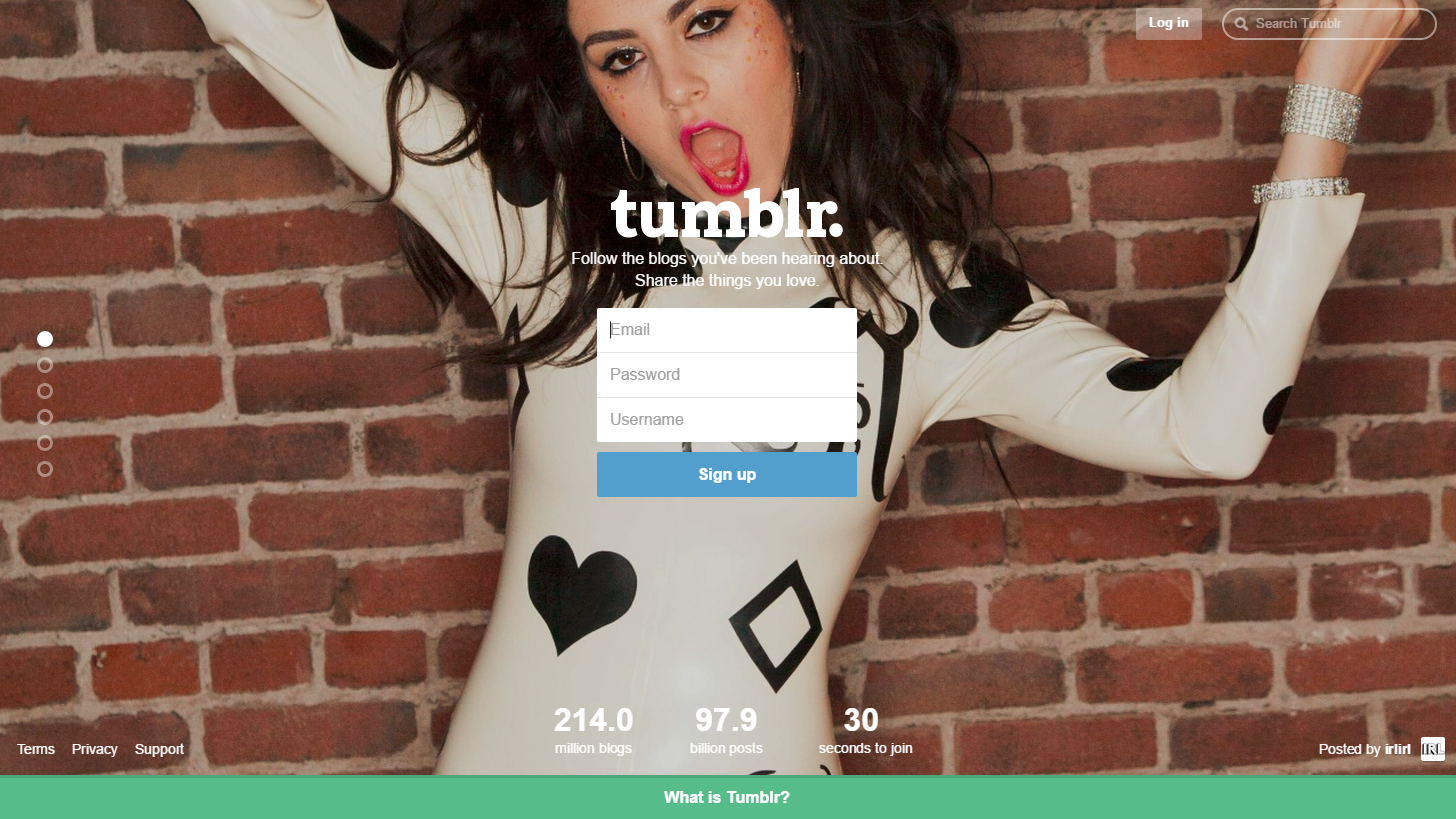
April 16, 2016: Tumblr and Pinterest are two of the fastest-growing social platforms. Tumblr, the web’s premier microblogging platform, was acquired by Yahoo in May of 2013 for $1.1 billion. It’s noted for its dashboard interface and extensive customizability (users can directly edit their page’s HTML code). Tumblr skews towards a demographic that is young, creative and hip, but brands catering to any given demographic can make a splash there. Currently (2016), Tumblr has 23.2 million active users.
Tumblr Demographics (from PewInternet.org):
Pinterest, a social bookmarking and sharing platform, launched in March of 2010. Users create collections of visual bookmarks in the form of boards consisting of pins which they can then invite friends to and share. These boards can be organized around identity and theme. Demographics skew towards women (83% globally); users can easily sign up using a Facebook or Twitter profile or an e-mail address. Pinterest is ideal for sharing collections of things users like or want, which makes the service a great way to measure affinity (something of great value to retailers and other commercial entities). Right now, Pinterest has 51.6 million users; that’s almost twice the size of Tumblr.
Pinterest Demographics (from PewInternet.org):
Tumblr offers these advantages to marketers:
It’s the leading personal blogging and publishing site. For PR and branding purposes, Tumblr can’t be beat. For bands, creatives, and personalities, the service provides amazing functionality for social sharing, media hosting, and other functions. It’s easily update-able and supports many plugins.
It’s the leading platform for rapid site prototyping. Need a web page concept thrown up immediately at a low cost? Use Tumblr.
It’s the go-to platform for developing brand fandom. Have a new TV series, product, or concept for which you want to develop brand advocacy? Find and build your army on Tumblr.
It’s also excellent for films promotion and PR. Witness the Hunger Games Capital Couture
Content on Tumblr is hugely shareable and plays very nicely with other social platforms. Tumblr can directly feed into Twitter and Reddit, for example.
It’s a cheap and simple alternative to WordPress for bloggers. Tumblr is easier to set up than a WordPress blog, doesn’t require you to contract with a hosting provider, offers almost as much functionality, and has an entire social network behind it. While Tumblr’s native analytics are rudimentary, you can integrate Google Analytics with your Tumblr blog to get richer reports. Tumblr also has analytics plug-ins available from providers such as Union Metrics.
But Pinterest is not without its charms:
Pinterest is more about things than about people. The service is a welcome respite from “look at me” social media culture and is more about “look at this.” Images of products are welcome — in fact they’re a big part of the fun on Pinterest.
It’s also good for brands that are merchandisers and retailers. Pinterest’s board-centric organization is perfect to highlight visual displays of cool stuff, especially cool collections.
It’s carving out a position as a platform for educational content. Teachers are now using Pinterest as a place to post lesson plans and Pinterest is also a leading source of infographics, competing directly with Visual.ly and Slideshare.
Pinterest can have strong positive effects on SEO. Links from Pinterest are normally no-follow, so there’s no direct SEO benefit to having a position there. But a well-curated, well-organized Pinterest presence, including the correct keywords and images, can indirectly boost SEO, because the odds that you’ll gain do-follow links from people exposed to your Pinterest boards will increase over time.
Analytics. Pinterest analytics reports impressions, re-pins, clicks, likes and rich pins activity. You can also track Pinterest from GA to get a more complete picture of how you’re faring.
Which one is better for marketers?
Tumblr and Pinterest are platforms that speak to different marketing needs. A good analogy is that Pinterest boards provide a gallery/museum experience, whereas a Tumblr area serves as a “storybook.”
Social media bandwidth permitting, it’s best to have a presence on both, for example, by using Pinterest to provide updates and “sneak peaks” of new products, and using Tumblr for direct storytelling and brand building. The result can be a deep campaign that creates multiple levels of engagement and performance.
Both platforms have a lot to offer. The choice as to where to engage should be based on your own brand identity, your audience, your internal (or agency) resources, and the strategic goals that you have for your brand and the specific product and campaign you have in mind. On the other hand, your decision may be very easy to make, if it happens that one of more of your direct competitors have a presence on Tumblr or Pinterest. In this case, carefully study the tactics they are employing and draw from them a set of best practices you can put to work on your own behalf.
- 10 Mistakes to Avoid When Using QR Codes for Marketing - September 20, 2023
- Kevin Lee on How AI Changes the SEO Landscape - August 31, 2023
- The Power of Compound Marketing: Kevin Lee Presents @ 1MediaWorld 2023 Global Conference - March 7, 2023

